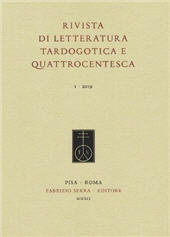Rivista di letteratura tardogotica e quattrocentesca
Perché dedicare una rivista alla letteratura tardogotica? Perché di stile tardogotico è la produzione poetica e prosastica del periodo che va dal 1340 al 1440 ed oltre, allorché giunge a compimento il processo di trasformazione dal gotico al gotico fiorito che si verifica contemporaneamente nella pittura, nella scultura, nell'architettura, nella letteratura e nella stessa musica con il passaggio dall'Ars Antiqua all'Ars Nova. I connotati fondamentali di questo tipo di produzione figurativa e letteraria sono lo scintillio delle immagini, la tendenza enciclopedica che si estrinseca con la minuziosa addizione di particolari, la costruzione di un sovramondo atemporale fastoso e dorato al cui centro campeggia la donna-luce o donna-sole - agli antipodi della spiritualizzata donna-angelo degli Stilnovisti -,
la quale irradia la sua sfolgorante luminosità fisica, e non etica, su di un paesaggio miniaturizzato e aprospettico fatto di lussureggianti giardini, di prati verdissimi cosparsi di fiori variopinti, di superbe fontane marmoree e d'interni sfarzosi, in una perenne e soleggiata primavera. L'arte tardogotica è eccessiva e disimpegnata, e riflette la visione del mondo terrena e paganeggiante propria dell'alta borghesia capitalistica fiorentina, le cui aspirazioni gentilizie la inducono a circondarsi di artisti e di scrittori, a farsi edificare magioni sontuose, arredate con pitture dal cromatismo sfavillante su sfondi giallo oro e con leggiadre sculture dalle posture sinuose e dall'elaborato gioco dei panneggi, ad esibire oggetti raffinati di un lusso principesco ed a vestire con ricercata eleganza.
Conseguentemente i ricchi esponenti di questa classe sociale prediligono la letteratura d'evasione, rigorosamente in volgare. Tale particolarissimo tipo di letteratura costituisce l'argomento di questa innovativa rivista che studia i rapporti tra letteratura, arti figurative e musica in un'età in cui tali rapporti furono più stretti che mai. Queste peculiarità stilistiche innervano tutta la produzione figurativa e letteraria - italiana e latina - del Quattrocento, che risente fortemente della poetica tardogotica e che va quindi indagata, per la prima volta nella storiografia italiana e straniera, anche sotto tale ottica. [Testo dell'editore]
Why a journal devoted to Late Gothic literature? Because Late Gothic style encompasses the poetic and prose production of the period from 1340 to 1440 and after, until the process of transformation from Gothic to flamboyant Gothic that occurred simultaneously in painting, sculpture, architecture, literature and music came to an end with the passage from Ars Antiqua to Ars Nova. Fundamental features of this type of figurative and literary production are its sparkling images, an encyclopedic tendency expressed by the meticulous addition of detail, the construction of a magnificent golden, timeless overworld in whose center stands the woman-light or woman-sun - the opposite of the spiritualized woman-angel of the Stilnovisti -
who shines her radiant brightness, physical rather than ethical, over a miniaturized and aperspectival landscape made of lush gardens, green meadows sprinkled with colorful flowers, superb marble fountains and sumptuous interiors, in a perennial and sunny spring. Late Gothic art is excessive and disengaged, and reflects the terrestrial and paganistic worldview of the Florentine capitalist bourgeoisie whose noble aspirations led it to surround itself with artists and writers, to have sumptuous mansions built and furnished with paintings of sparkling chromaticity on golden backgrounds as well as with graceful sculptures displaying sinuous postures and the elaborate play of draperies, to exhibit refined objects of princely luxury, and to dress with refined elegance.
Consequently, the wealthy members of this social class preferred escape literature, strictly in the vernacular. This very particular type of literature is the subject of this innovative journal, which studies the relationships between literature, the figurative arts and music in an age when those relationships were closer than ever before. These stylistic features animate all the figurative and literary production - Italian and Latin - of the Fifteenth century, which is strongly influenced by Late Gothic poetry and must therefore be investigated, for the first time in Italian and foreign historiography, also in this light. [Publisher's text]
-
Hefte derselben Zeitschrift (einzeln erhältlich)
-
Informationen
ISSN: 2704-713X
ERSCHEINUNGSWEISE
Annuale = Annual
ANVUR KLASSIFIKATION
ANVUR: Area 10, Fascia S


